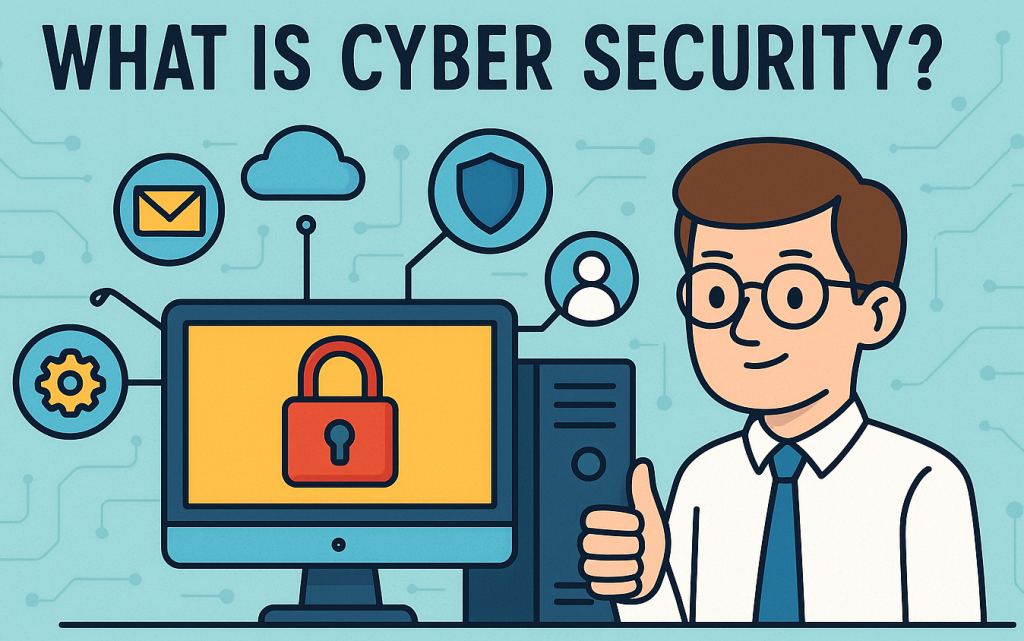In a world where data fuels business growth, what is cyber security and why does it matter so much? Every click, download, and transaction creates opportunities—not just for innovation, but also for cybercriminals. From phishing emails to ransomware attacks, modern businesses face digital threats that can cripple operations overnight. That’s where cyber security comes in—a discipline that safeguards systems, data, and users from evolving online threats.
Understanding the Concept of Cyber Security
Cyber security refers to the protection of computer systems, networks, and data from theft, damage, or unauthorized access. It encompasses a mix of technologies, policies, and practices that ensure information confidentiality, integrity, and availability—often called the CIA triad.
-
Confidentiality: Preventing unauthorized access to sensitive data.
-
Integrity: Ensuring data accuracy and trustworthiness.
-
Availability: Keeping systems and services operational when needed.
Cyber security isn’t limited to large enterprises. Whether you’re a startup, hospital, or global corporation, safeguarding digital assets is essential to maintaining trust and resilience.
Why Cyber Security Is Essential in Today’s Digital Economy
The shift toward remote work, cloud computing, and interconnected devices has dramatically expanded the attack surface. Hackers no longer need physical access—they exploit weak passwords, outdated software, and social engineering to infiltrate networks.
Key Reasons Cyber Security Matters:
-
Data Protection: Prevents unauthorized access or leaks of customer and business data.
-
Business Continuity: Reduces downtime and financial losses during attacks.
-
Regulatory Compliance: Ensures adherence to global data protection laws like GDPR or HIPAA.
-
Reputation Management: Builds customer trust by showing commitment to security.
-
Competitive Advantage: Secure organizations are more likely to win customer confidence and investor trust.
A single cyber incident can undo years of hard work—making prevention the smarter investment.
Common Types of Cyber Threats
Cybercriminals use a wide variety of tactics. Understanding these types of cyber security threats helps organizations prepare better defenses.
1. Phishing Attacks
Fake emails or messages that trick users into revealing credentials or clicking malicious links.
2. Ransomware
Malware that encrypts your files and demands payment for decryption keys—often disrupting entire organizations.
3. Denial of Service (DoS) Attacks
Overwhelms a server or network, rendering it inaccessible to legitimate users.
4. Insider Threats
Employees or contractors who intentionally or accidentally compromise systems.
5. Zero-Day Exploits
Attacks that take advantage of vulnerabilities before developers can issue patches.
6. Man-in-the-Middle (MitM) Attacks
Hackers intercept communications between two parties to steal or alter information.
These are only a few of the countless cyber threats evolving daily—reinforcing why businesses need continuous vigilance.
Core Areas of Cyber Security
Cyber security is a broad field made up of specialized domains, each addressing unique risks.
1. Network Security
Protects internal networks from intrusions using firewalls, intrusion detection systems, and encryption.
2. Endpoint Security
Safeguards individual devices like laptops, phones, and IoT devices that connect to the corporate network.
3. Application Security
Ensures software and applications are designed and updated to resist attacks.
4. Cloud Security
Protects data, applications, and services hosted on cloud platforms through encryption, access control, and monitoring.
5. Identity and Access Management (IAM)
Manages user identities and controls who can access specific systems and data.
6. Operational Security (OpSec)
Involves monitoring and managing security operations, including incident response and threat analysis.
By combining these layers, organizations can build a multi-tiered defense system that minimizes vulnerabilities.
Building a Strong Cyber Security Strategy
A successful cyber security program aligns technology with human awareness and organizational processes.
1. Conduct Risk Assessments
Identify critical assets, potential vulnerabilities, and threat exposure. Prioritize risks based on business impact.
2. Implement Multi-Layered Protection
Combine firewalls, antivirus, encryption, and AI-powered threat detection tools.
3. Strengthen User Awareness
Train employees to recognize phishing attempts, avoid unsafe downloads, and follow data protection policies.
4. Develop an Incident Response Plan
Prepare procedures for identifying, containing, and recovering from attacks efficiently.
5. Regular Updates and Patching
Keep all systems, software, and devices updated to close exploitable security gaps.
6. Collaborate with Security Partners
Work with Managed Security Service Providers (MSSPs) or cyber consultants for 24/7 monitoring and compliance support.
When leadership, IT, and employees share responsibility, cyber security transforms from a cost to a strategic advantage.
Emerging Trends in Cyber Security
The digital threat landscape continues to evolve, and organizations must stay one step ahead.
-
AI-Powered Security: Machine learning helps detect anomalies faster than manual monitoring.
-
Zero Trust Architecture: “Never trust, always verify” access model gaining adoption.
-
Cloud and Hybrid Security: Secure configurations and compliance across multi-cloud environments.
-
Quantum-Resistant Encryption: Future-proofing data against quantum computing capabilities.
-
Regulatory Expansion: More global regulations enforcing transparency and accountability in data protection.
For IT managers and CEOs, staying updated on these developments ensures strategic decision-making aligns with global trends.
Benefits of Investing in Cyber Security
-
Reduced Financial Losses: Avoid breach recovery costs.
-
Improved Trust and Reputation: Customers and partners feel safer engaging with secure brands.
-
Regulatory Confidence: Easier compliance with data laws and audits.
-
Operational Efficiency: Secure automation and better IT performance.
-
Business Longevity: Resilience against evolving digital disruptions.
Cyber security isn’t just a defense—it’s the backbone of sustainable digital growth.
Frequently Asked Questions (FAQ)
Q1: What is cyber security in simple terms?
Cyber security is the practice of protecting systems and data from digital attacks through technology, policies, and user awareness.
Q2: What are examples of cyber attacks?
Examples include phishing emails, ransomware infections, data breaches, and DDoS (denial-of-service) attacks.
Q3: How can small businesses improve cyber security?
By using strong passwords, enabling multi-factor authentication, updating software, and educating employees about cyber threats.
Q4: What skills are important for cyber security professionals?
Knowledge of networking, ethical hacking, cloud platforms, cryptography, and incident response.
Q5: How often should companies update their cyber security strategy?
At least annually or after significant business or technology changes.
Conclusion
Understanding what is cyber security is more than a technical exercise—it’s a business imperative. Every organization, regardless of size or industry, must protect its data, infrastructure, and reputation. With proactive defense, continuous monitoring, and employee education, businesses can stay ahead of cybercriminals and thrive securely in a connected world.
Ready to strengthen your defense?
Start by auditing your current security measures, educating your workforce, and investing in tools that protect your business from the next wave of digital threats.











